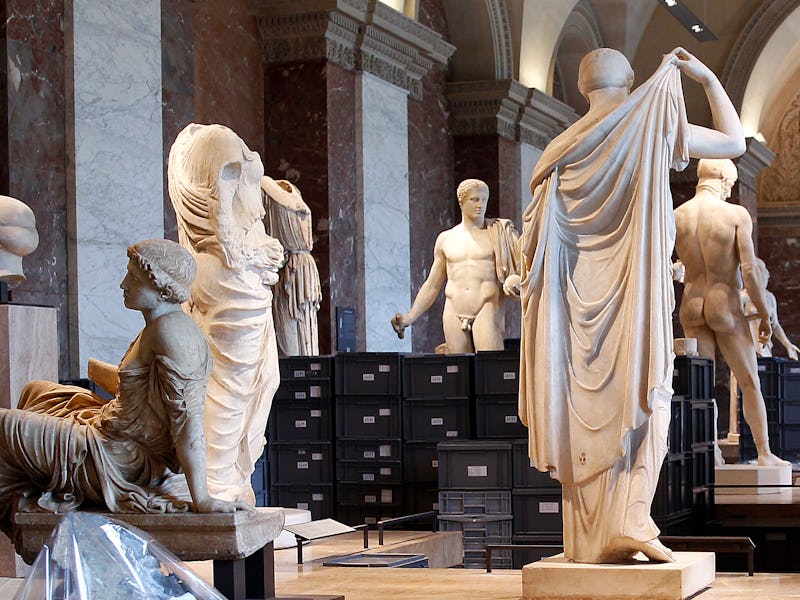Climate Change Could Soak the Art World
The Mona Lisa, Venus de Milo, and Lady Liberty may end up in a raft together.

Tourists hoping to get a glimpse of the Mona Lisa last month were turned away by the rising waters of the Seine, which threatened to flood the Louvre. Climate change, scientists concluded, was to blame for the extreme rainfall, which forced curators at the iconic museum to frantically box up its precious artifacts.
It won’t be the last time that happens: As rapidly rising tides and torrential rains become the new normal in cities around the globe, the chances that priceless works of art live to see 2100 grow increasingly slim. Some of the world’s most important art collections are housed in cities predicted to have a much wetter future. Many of them are already getting soaked in it.
So, collectors, get some bigger crates. Here are six works of art about to be slapped by the wet hand of climate change.
Regard the Class Struggle as the Main Link in the Chain, Kehinde Wiley
Along the walls of Pérez Art Museum Miami, a contemporary art museum on the edge of Biscayne Bay, hangs an extensive collection featuring the work of many prominent living artists, including the mixed-media artist Jamaican-American Nari Ward (Happy Smilers Duty Free Shopping), sculptor Mark Handforth (Western Suns), and, notably, the American portraitist Kehinde Wiley. The museum also happens to sit on a disappearing coastline; climate change scientists have warned that the Miami Bay waterfront could see a 9-foot sea level rise as soon as 2050. The airy building itself, its floors teetering above the bay on elegant columns, was designed by Herzog & de Meuron and cost a cool $220 million to build.
Venus de Milo
The torrential downpour that rained down on the Seine initially came as a surprise, but the recent analysis by the World Weather Attribution partnership showed that a three-day extreme rainfall event was now 80 percent more likely to happen along the river’s banks because of climate change. What does that mean for the Louvre? Aside from having to get used to boxing up its entire first floor — that is their Islamic, Coptic, Greek, Etruscan, and Roman collections — on a moment’s notice, it’ll have to start revamping its 2002 flood contingency plan. If they don’t, the priceless Venus de Milo, together with the Ancient Greek Kore of Samos, the Rampin Head, and the Daedalic masterpiece known as the Lady of Auxerre, could all be lost for good.
Light Red Over Black, Mark Rothko
The Tate Modern, which just unveiled its new pyramid tower as part of its 260-pound revamp, sits on the south bank of the Thames, where staying dry won’t be easy. Earlier this year, massive tides and pouring rain caused the banks of the Thames to break, causing millions of dollars’ worth of property damage. If the same thing happens downstream, Mark Rothkos multiple “Untitled” works, Agnes Martin’s Japanese-inspired sculpture The Garden, and Ai Weiwei’s massive Tree, standing in the middle of the Tates Turbine Hall, could all be lost to the flood.
Last Supper, Tintoretto
The Bride of the Sea is herself a work of art; if her marriage goes south — and by the latest estimates, it will — it’s more than just a handful of galleries that’ll drown. Venice is sinking by 2 mm per year, and a recent U.N. report placed the city high on its list of threatened heritage sites. Among the priceless works of art and architecture that comprise the city, Tintoretto’s Last Supper, an invaluable oil painting on canvas dated to 1592, is housed within the city’s Basilica di San Giorgio Maggiore. The painting, noted for its Renaissance-subverting “modern” take on perspective and light, was recently included in the 2011 Venice Biennale.
The Statue of Liberty
Lady Liberty herself better learn to swim. The U.N.-sponsored report that put Venice on watch also called New York’s Statue of Liberty as another one of the world’s heritage sites most highly threatened by climate change. The value of the Statue, together with its home Liberty Island and nearby Ellis Island, is estimated at $1.5 billion, the report says, “but the intangible cost of future damage to this international symbol of freedom and democracy is incalculable.” While multiple photos of the famed statue drowning in the aftermath of Hurricane Sandy were proven to be fakes, future photographers most likely won’t need to resort to Photoshop, as rising temperatures in the North Atlantic are expected to make local hurricanes more intense.
My Backyard, Georgia O’Keeffe
Hurricane Katrina drove home how much New Orleans stands to lose to the devastating effects of climate change. Among its many cultural treasures, NOLA is also home to NOMA — the New Orleans Museum of Art — the South’s premier art collection, housing over 40,000 works of fine art from contemporary artists. One notable piece is Georgia O’Keeffe’s “My Backyard,” the renowned American painter’s soft, sensual rendering of the red mountains behind her home in Abiquiú, New Mexico; by Christie’s last estimate, New Orleans stands to lose a cool $1.8 million for the painting if it succumbs to the rising seas and more intense hurricanes that the NRDC currently predicts will befall the city.